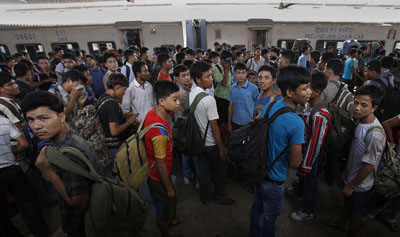Indian Internet advocates and journalists are in an uproar this week over the news that the government has blocked access to around 300 websites, pages, and social media accounts in an effort to quell communal violence in the turbulent northeast. The rationale is that inflammatory online content has fanned tensions between Muslims and non-Muslims in states including Assam, Karnataka, Tamil Nadu, and Maharashtra, contributing to a mass exodus from the region and violence in other cities. The offending content included fabricated images of violence against Muslims, apparently circulated to incite retaliatory attacks, according to news reports.
India limited cell phone SMS messages to five per user per day for 15 days, and instructed Internet Service providers and companies, including Facebook and Google, to cut off access to the doctored content, the reports said. Those companies said publicly that they complied where the requests were in accordance with international norms and their own user guidelines, according to the BBC. Twitter was less responsive, the BBC reported.
Speech that can incite imminent violence contravenes international law, but India’s knee-jerk censorship has worrying implications for press freedom. Bangalore’s Center for Internet and Society notes that some local and international news outlets were blocked between August 18 and August 21, including Al-Jazeera and the UK’s Telegraph.
The center’s Pranesh Prakash goes on to list some other ways that the blocking has infringed on the media’s regular operations. We’ve reproduced three here with minor edits for clarity:
- Most importantly, even people and posts debunking rumors have been blocked.
- Some of the Twitter accounts are of prominent people who write for the mainstream media.
- Quite a number of the links include articles published and reports broadcast in the mainstream media (including a Times Now report, a Telegraph picture gallery, etc.), making the blocks suspect.
There are still more causes for concern. With SMS news services increasingly essential in areas with low Internet penetration, restricting mass texts is no longer simply a freedom of speech issue–it affects the news, too. While India has the third largest online population in the world, rural areas and low-income communities rely on mobile phones to connect with the outside world.
What’s more, if Indian officials had a strong record of working with advocates of free expression over Internet regulation, they might have avoided some of the pushback they have faced domestically. But they don’t. Many observers believe that the government’s motivation lies beyond simply barring speech that could incite violence; they believe other motives include “polishing the government’s image,” to borrow a phrase from London-based analyst Angela Saini.
Some aspects of the official response to the crisis lend weight to this view. India’s Home Ministry alleged that some of the doctored content originated in Pakistan, according to news reports. Yet with few Pakistani websites the target of blocks, the basis for that assertion is not yet apparent, according to the Center for Internet and Society. The Indian Express reported that only one-fifth of the banned pages even mentioned the northeast, and that inflammatory posts on that region were largely from Indian users. (Some questionable content about the treatment of the Muslim Rohinga minority in Burma may have originated in Pakistan, according to the Express.) The subsequent spat between Islamabad–which denied the allegations–and New Delhi–which promised to release “proof” of Pakistan’s intentions–politicized the issue without calming tensions. Then the government threatened websites with legal action if the content was not removed, news reports said. Finally, on Tuesday, Internet service providers blocked six Twitter accounts spoofing India’s Prime Minister Manmohan Singh, after Twitter did not respond to June requests to take them down, according to the BBC. (Twitter has said it is reviewing that request now.)
It is unfortunate that this effort to tamp down on caricatures of the prime minister comes at a time when other online information might legitimately be putting citizens’ lives at risk, since it casts the rest of the government’s response to the emergency in a distinctly self-serving light. By not communicating effectively with the online community (where was the government’s social media outreach to debunk the fabricated images of violence?), by bullying intermediary technology companies to enact blocks, and by muddying their message with political issues, India has turned a sensitive communal issue into a sensitive freedom-of-information one. This is not the last time the country will face difficult decisions about online information. Let’s hope it’s the last time it’s this badly managed.
